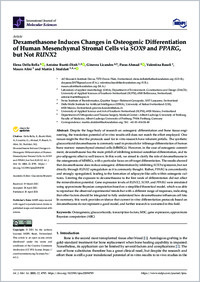Dexamethasone induces changes in osteogenic differentiation of human mesenchymal stromal cells via SOX9 and PPARG, but not RUNX2
- Della Bella, Elena AO Research Institute Davos, Davos, Switzerland
- Buetti-Dinh, Antoine Laboratory of applied microbiology (LMA), Department of Environment, Constructions and Design (DACD), University of Applied Sciences of Southern Switzerland (SUPSI), Bellinzona, Switzerland - Swiss Institute of Bioinformatics, Lausanne, Switzerland
- Licandro, Ginevra Istituto Dalle Molle di studi sull'intelligenza artificiale (IDSIA), Facoltà di scienze informatiche, Università della Svizzera italiana, Svizzera - University of Applied Science and Art of Southern Switzerland (SUPSI), Manno, Switzerland
- Ahmad, Paras AO Research Institute Davos, Davos, Switzerland
- Basoli, Valentina AO Research Institute Davos, Davos, Switzerland
- Alini, Mauro AO Research Institute Davos, Davos, Switzerland
- Stoddart, Martin J. AO Research Institute Davos, Davos, Switzerland - Department of Orthopedics and Trauma Surgery, Medical Center, Faculty of Medicine, Albert-Ludwigs-University of Freiburg, Freiburg, Germany
-
30.04.2021
Published in:
- International journal of molecular sciences. - MDPI. - 2021, vol. 22, no. 9, p. 16
Osteogenesis
Glucocorticoids
Transcription factors
MSC
Gene expression
Approximate Bayesian computation (ABC)
English
Despite the huge body of research on osteogenic differentiation and bone tissue engineering, the translation potential of in vitro results still does not match the effort employed. One reason might be that the protocols used for in vitro research have inherent pitfalls. The synthetic glucocorticoid dexamethasone is commonly used in protocols for trilineage differentiation of human bone marrow mesenchymal stromal cells (hBMSCs). However, in the case of osteogenic commitment, dexamethasone has the main pitfall of inhibiting terminal osteoblast differentiation, and its pro-adipogenic effect is well known. In this work, we aimed to clarify the role of dexamethasone in the osteogenesis of hBMSCs, with a particular focus on off-target differentiation. The results showed that dexamethasone does induce osteogenic differentiation by inhibiting SOX9 expression, but not directly through RUNX2 upregulation as it is commonly thought. Rather, PPARG is concomitantly and strongly upregulated, leading to the formation of adipocyte-like cells within osteogenic cultures. Limiting the exposure to dexamethasone to the first week of differentiation did not affect the mineralization potential. Gene expression levels of RUNX2, SOX9, and PPARG were simulated using approximate Bayesian computation based on a simplified theoretical model, which was able to reproduce the observed experimental trends but with a different range of responses, indicating that other factors should be integrated to fully understand how dexamethasone influences cell fate. In summary, this work provides evidence that current in vitro differentiation protocols based on dexamethasone do not represent a good model, and further research is warranted in this field.
- Language
-
- English
- Classification
- Medicine
- License
- Open access status
- gold
- Identifiers
-
- RERO DOC 333699
- DOI 10.3390/ijms22094785
- ARK ark:/12658/srd1319367
- Persistent URL
- https://n2t.net/ark:/12658/srd1319367
Statistics
Document views: 224
File downloads:
- Texte intégral: 296
